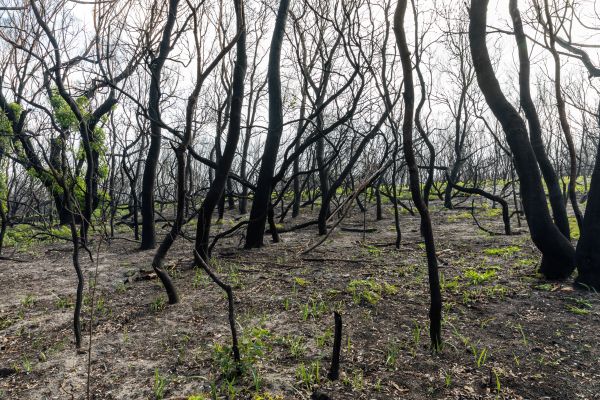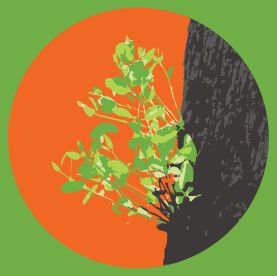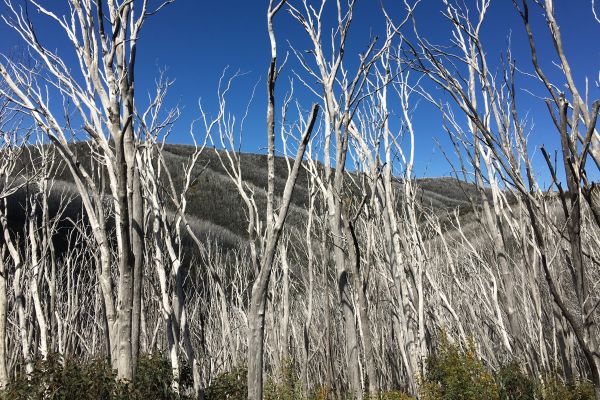Weed management after fire - Webinar series

After bushfire, our ecosystems are at their most vulnerable to weed invasion. Help us support indigenous flora and fauna by managing weeds in bushfire affected areas.

This webinar series focuses on sharing practical knowledge so everyone can contribute to bushfire recovery.
View recordings and shared links
Webinar 1 - Overview weed management after fire
Webinar 2 - Prioritisation of weeds after fire
Webinar 3 - Collaborative projects in weed management after fire
Webinar 4 - Weed identification and recording after fire
or the complete event sereies 2020 Weed Management after Fire Webinar series - YouTube
Webinar 1: Wednesday 25 November 2020 - Overview weed management after fire.
- Bushfire Response and Recovery Program: Threat Management - Damien McMaster Bushfire Biodiversity Response & Recovery (BBRR) Program, Department of Environment, Land, Water and Planning (DELWP), East Melbourne, Victoria:
- Environmental weed management after fire - principles to practice - Dr Judy Fisher, Fisher Research Pty Ltd, IUCN CEM Ecosystems and Invasive Species, Institute of Agriculture University and Western Australia:
- Central Highlands Eden – a model for weed management after fire - Sally Lambourne – Central Highlands Eden Project Manager; and Brad Matthews – Central Highlands Eden Project Officer, Department of Environment, Land, Water and Planning (DELWP), Knoxfield, Victoria:
Recording of Webinar 1 on 25 November 2020
Links shared in Webinar 1
Bushfire Response and Recovery Program: Threat Management - Damien McMaster Bushfire Biodiversity Response & Recovery (BBRR) Program, Department of Environment, Land, Water and Planning (DELWP), East Melbourne, Victoria:
- Bushfire Biodiversity Response and Recovery (BBRR) program
- Victoria’s bushfire emergency: biodiversity response and recovery Version 2 (August 2020). pdf
- Post-fire weeds triage manual, Black Saturday Victoria 2009 – Natrual Values fire recovery program pdf
- Strategic Management Prospects (SMP) and NaturePrint
- NatureKit
- Contact Damien McMaster via email
Environmental weed management after fire - principles to practice - Dr Judy Fisher, Fisher Research Pty Ltd, IUCN CEM Ecosystems and Invasive Species, Institute of Agriculture University and Western Australia:
- Theme Leader IUCN Ecosystems and Invasive Species
- Facebook page for the IUCN Thematic Group
- Expert Panel of the Intergovernmental Science Policy Platform on Biodiversity and Ecosystem Services (IPBES)
- IPBES global assessment on Invasive Species
- Contact Judy Fisher via email or Twitter: @judithfish
Central Highlands Eden – a model for weed management after fire - Sally Lambourne – Central Highlands Eden Project Manager; and Brad Matthews – Central Highlands Eden Project Officer, Department of Environment, Land, Water and Planning (DELWP), Knoxfield, Victoria:
- Weeds and Pests on Public Land (WPPL) Program
- Contact Sally Lambourne via email
- Contact Brad Mathews via email
Other relevant links:
- Weeds at the Early Stage of Invasion (WESI)
- WESI Early Invader Manual pdf
- WESI Early Invader Weeds Update Newsletter
Webinar 2: Wednesday 2 December 2020 - Prioritisation of weeds after fire.
- Prioritising invasive plant control after very high severity wildfire - Steve Taylor, Program Leader (Invasive Plants), Environment, Planning and Sustainable Development Directorate, ACT Parks Invasive Plants Program
- Prioritising weeds in the Glenelg Eden using the feasibility of eradication tool - Mitch Williams, Project Manager Glenelg Eden, Department of Environment, Land, Water and Planning (DELWP), Heywood, Victoria
- Prioritising weeds in the Hume Region after fire - Daniel Littlewood, Bushfire Biodiversity Recovery Project Officer, Department of Environment, Land, Water and Planning (DELWP), Ovens, Victoria
- Prioritising for native regeneration, with weed control per se a lesser goal. - Dr Tein McDonald, Australian Association of Bush Regenerators (AABR).
Please note we experienced some audio issues with our first presenter that we were unable to resolve. We apologies for this unfortunate issue. The remaining three presentations have clear audio and we hope that you will continue to watch the recording. You can skip to the next speaker at the 37 min point. You can also view a higher quality recording of Steve Taylor’s weed management program in ACT presented at the CAL – IPC symposium, October 2020. View Steve Taylor’s presentation played via Google Drive.
Recording of Webinar No. 2 on 2nd December 2020.
Links shared in Webinar 2
1. Prioritising invasive plant control after very high severity wildfire - Steve Taylor, Program Leader (Invasive Plants), Environment, Planning and Sustainable Development Directorate, ACT Parks Invasive Plants Program:
- iNaturalist
- ACT Parks Invasive Plants Program
- ACT & SE NSW Invasive Plants public group on Facebook
- Namadgi National Park
- View Steve Taylor’s presentation played via Google Drive. (A higher quality recording of Steve Taylor’s weed management program in ACT presented at the CAL – IPC symposium, October 2020).
- Contact Steve via email and @Steve818 iNaturalist AU
2. Prioritising weeds in the Glenelg Eden using the feasibility of eradication tool - Mitch Williams, Project Manager Glenelg Eden, Department of Environment, Land, Water and Planning (DELWP), Heywood, Victoria
- Glenelg Eden Project ('weed control section')
- Glenelg Eden celebrates 10 years of pest plant management (May 2018)
- WESI Early invader manual includes template of “Feasibility of eradication score sheet” pdf
- Contact Mitch via email
3. Prioritising weeds in the Hume Region after fire - Daniel Littlewood, Bushfire Biodiversity Recovery Project Officer, Department of Environment, Land, Water and Planning (DELWP), Ovens, Victoria:
4. Prioritising for native regeneration, with weed control per se a lesser goal - Dr Tein McDonald, Australian Association of Bush Regenerators (AABR).
- AABR
- AABR Facebook Page - Bush Regenerators
- Post-fire bush regeneration Facebook Group (by AABR)
- Seedling recognition Facebook Group (by AABR)
- AABR Locator map for linking sites in need with helpers
- Post-wildfire video series on YouTube
- Contact Tein via e-mail
Webinar 3: Wednesday 9 December 2020 - Collaborative projects -weed management after fire.
- Working together to help biodiversity recover after fire: Keith Primrose, Environment, Land and Water Area of Work Coordinator, Parks Victoria, Mt Beauty
- Collaboration for biodiversity recovery: Deirdre Griepsma, Regional Biodiversity Recovery Program Coordinator, Parks Victoria, Inverloch
- Weed management after fire in an urban environment: Calum Walker, DELWP, Bendigo, Victoria
- Weed management in a remote catchment: Protecting the critically endangered Spotted Treefrog in the Wongungarra: Glen Johnson, Regional Biodiversity Recovery Coordinator, DELWP Hume Region; and Mel Birleson, Project Coordinator, East Gippsland Catchment Management Authority (EGCMA)
Recording of Webinar No. 3 on 9th December 2020.
Links shared in Webinar 3
- Parks Victoria
- Victoria’s bushfire emergency: Biodiversity response and recovery website
- Victoria’s bushfire emergency: biodiversity response and recovery report pdf
1. Working together to help biodiversity recover after fire: Keith Primrose, Environment, Land and Water Area of Work Coordinator, Parks Victoria, Mt Beauty:
- Strategic Management Prospects - Natureprint
- NatureKit
- NSW/VIC Weeds Conference
- Australasian Weeds Conference
- Contact Keith Primrose via e-mail
2. Collaboration for biodiversity recovery: Deirdre Griepsma, Regional Biodiversity Recovery Program Coordinator, Parks Victoria, Inverloch:
- Contact Deirdre Griepsma via e-mail
3. Weed management after fire in an urban environment: Calum Walker, DELWP, Bendigo, Victoria;
- Post fire weed control and revegetation following bushfire in an urban environment at Bendigo, Victoria. Black Saturday Victoria 2009 pdf – Natural values fire recovery program. Calum Walker, Alex Sedger - Department of Sustainability and Environment 2012
- Natural Values Recovery Program following the 2009 bushfires
- Early Invader Update feature issue #18 from 14 February 2020 pdf
- Contact Calum Walker via e-mail
4. Weed management in a remote catchment: Protecting the critically endangered Spotted Treefrog in the Wongungarra: Glen Johnson, Regional Biodiversity Recovery Coordinator, DELWP Hume Region; and Mel Birleson, Project Coordinator, East Gippsland Catchment Management Authority (EGCMA):
- East Gippsland Catchment Management Authority
- Spotted Tree Frog (Litoria spenceri) Action Statement (Victoria) pdf
- Spotted Treefrog (Federal Government)
- Frog ID app
- Australian Museum: Australia’s Native Frogs
- Amphibian Chytrid Fungus Disease pdf
- Grey Sallow Willow (Salix cinerea)
- Victorian Biodiversity Atlas (VBA)
- Contact Glen Johnson via e-mail
- Contact Mel Birleson via e-mail
Webinar 4: Wednesday 16 December 2020 - Weed identification and recording after fire.
- Environmental weed recognition after fire and taking better photos with a mobile device: Kate Blood and Bianca Gold, Weeds at the Early Stage of Invasion (WESI) Project, DELWP, Statewide, Victoria
- Recording weed distribution in the Otway Eden: Dale Fuller, Parks Victoria
- Darcy Duggan Memorial Lecture: Search and detect for weeds; the importance of working out how much you have before starting treatment: Associate Professor Randall Robinson, Executive Director Institute for Sustainable Industries and Liveable Cities, Victoria University Research, Victoria University
Recording of Webinar 4 on 16th November 2020
Links shared in Webinar 4
1. Environmental weed recognition after fire and taking better photos with a mobile device: Kate Blood and Bianca Gold, Weeds at the Early Stage of Invasion (WESI) Project, DELWP, Statewide, Victoria:
- Weeds at the Early Stage of Invasion (WESI)
- Early invader manual pdf
- Guide No.2 – Looking for weeds: name and notify pdf
- Weed risk ratings and the Advisory list of environmental weeds in Victoria
Useful links for weed ID and distribution information
- Weeds of Australia, Biosecurity Queensland Edition, Fact Sheet Index
- Agriculture Victoria; biosecurity - weeds
- Opuntioid management resources including field ID guide and management manual
- AusGrass2 (for Grass ID)
- Invasive Species Compendium (CABI)
- NSW WeedWise
- Weeds Australia
- Atlas of Living Australia
- SEEK by iNaturalist and iNaturalist
- Contact Kate Blood via e-mail and @weedyk8 on social media.
- Contact Bianca Gold via e-mail and Bianca Goldweeds via facebook
WESI is funded by the Victorian Government by the Weeds and Pests on Public Land Program (WPPL)
2. Recordingweed distribution in the Otway Eden: Dale Fuller, Parks Victoria
- Otways threatened species forum abstracts
- ArcGIS collector app
- ANGAIR (Anglesea, Aireys Inlet Society for the Preservation of Flora and Fauna) - Managing pest species
- Victorian Biodiversity Atlas (VBA): https://www.environment.vic.gov.au/biodiversity/victorian-biodiversity-atlas
- NatureKit
- Strategic Management Prospects (SMP)
- Contact Dale Fuller via e-mail
Otway Eden and other Eden projects are funded by the Victorian Government through the Weeds and Pests on Public Land Program (WPPL)
These webinars are funded by the Victorian Government’s $22.5 million Bushfire Biodiversity Response and Recovery program. For more information on the BBRR program, visit www.wildlife.vic.gov.au/home/biodiversity-bushfire-response-and-recovery


